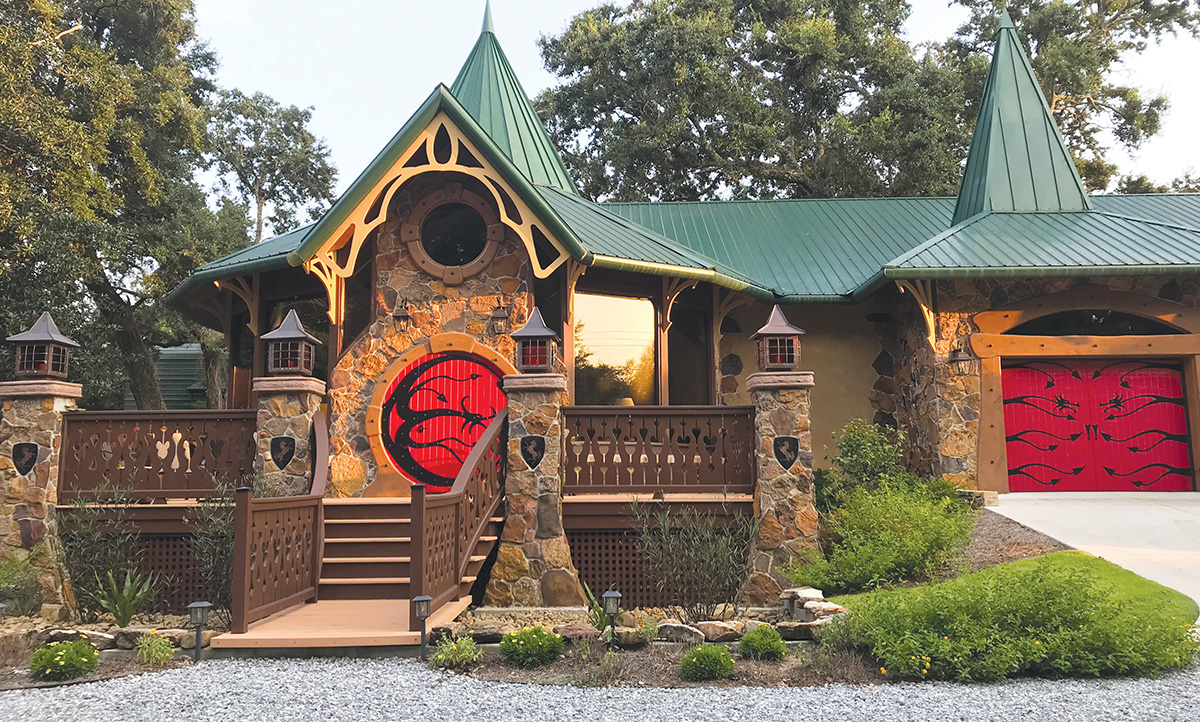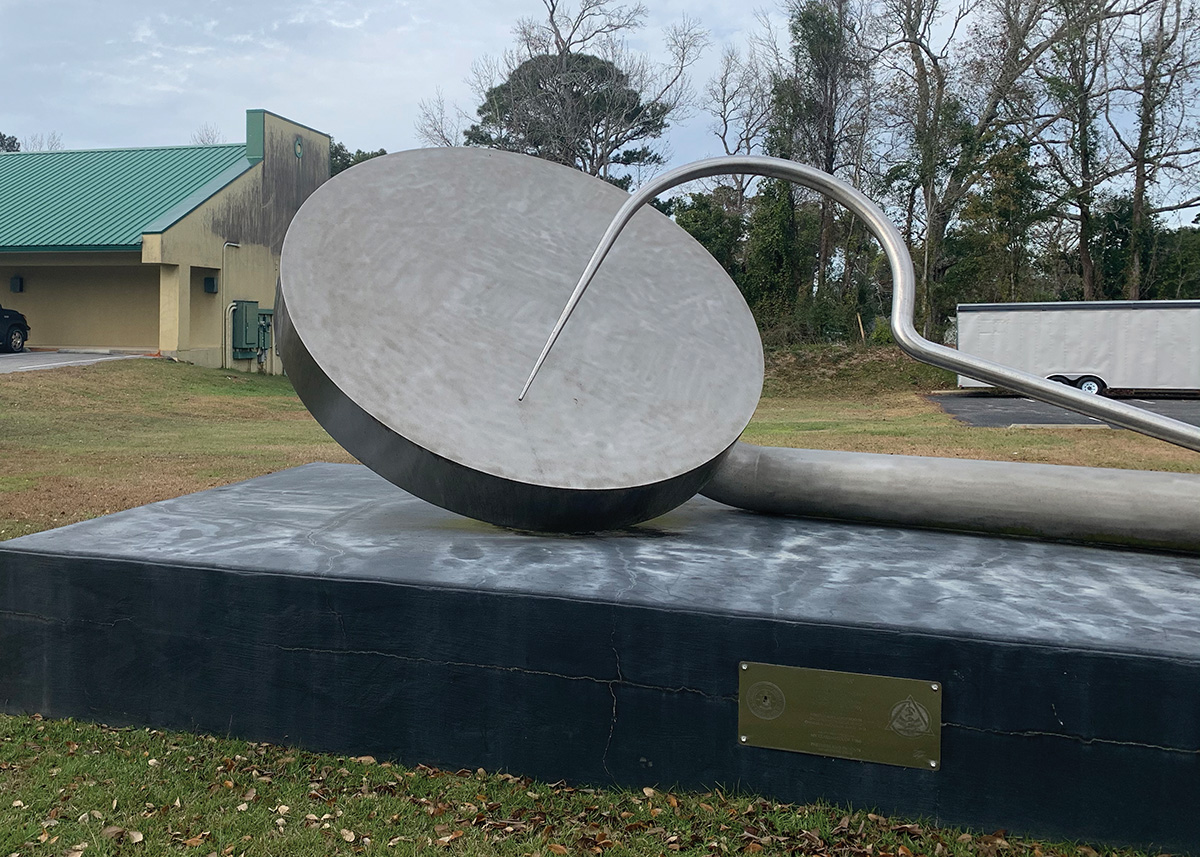A castle. A dental implement. A submarine. What do all of these things have in common? Absolutely nothing. Unless you live in Lower Alabama.
Roadside attractions reflect the people living in a particular place, so it’s no surprise that the Mobile Bay area has some oddball, surprising and downright fascinating artifacts lining its roadways. Some are inspiring, others strange and a few just flat-out weird. Here are nine unusual sites that are quite a sight — within two hours of Mobile.

United States Sports Academy, Daphne | The Art of Sports and Spare Parts
Poet John Keats was right: “A thing of beauty is a joy forever.” But so is scrap metal with the right touch. Fairhope artist Bruce Larsen has that touch. On the campus of the United States Sports Academy at One Academy Drive, Daphne, he has transformed junk into metallic masterpieces.
His work includes an Olympic swimmer, professional baseball player, gymnast and other famous titans of sports. Each is made of metal scraps: tractor parts, automotive engines, flywheels, chain drives, plumbing fixtures and more. A favorite is “The Iron Bowl,” unveiled by Nick Saban and others on May 18, 2010. Look closely at the football that two helmeted warriors are fighting for. “The ball is actually two headlights, back to back, from Model A cars,” Larsen says with a smile.

Oak Avenue, Fairhope | Home Sweet Castle

Yes, the Eastern Shore has castles. Three are in Fairhope, regally embedded on Oak Avenue: Mosher, Sheldon and Boom Hobbit. Collectively they are awesome castles, by day or knight.
“Some children claim it’s the tower of Rapunzel. Others say Cinderella lives here, and some call it home to Hansel and Gretel,” says Pagan Mosher who, with husband Dean, designed and built the whimsical neighborhood. “The castles are whatever you want them to be.”
Exploring exterior grounds is free. Visitors stroll seemingly enchanted paths and a bridge over goldfish waters. Artwork and wonders await every turn. Mosher Castle is full of renowned artist Dean Mosher’s paintings, sculptures and family memorabilia. Interior tours are available by reservation.
The fortresses have been featured on HGTV, Alabama Public Television, syndicated broadcasts and thousands of selfie photos. However, Fairhope’s castles are residential homes — no backyard visits, walking on porches and decks, and no peeking in windows. King Arthur is not here.
For more information, visit fairhopecastle.com.

Montrose | Tolstoy Park’s Hermit
In 1923, Nampa, Idaho, resident, Henry Stuart, was diagnosed with tuberculosis and advised to move to a warmer climate. He purchased 10 acres in what is now Montrose, built a 14-foot diameter domed hut and named it Tolstoy Park.
Surrounded by an office park on 22787 U.S. Highway 98, Stuart’s hut still stands. Visitors can enter the tiny one-room structure, which includes period furnishings, a wood-burning stove and a guest book.
For those feeling claustrophobic standing in this tiny dwelling that could fit in a two-car garage, consider Stuart. He resided in the diminutive dwelling for almost 20 years before moving to Oregon to live with his son. Stuart died in 1946.

Lucedale, Mississippi | Palestine Gardens: Replica of the Holy Land
Behold, Lucedale, Mississippi, where thou shalt visit Palestine Gardens, The Holy Land. Beside tranquil paths and shady trees are miniature replicas of the Bible’s most renowned sites, crafted in miniature.
“It’s folk art,” Director Don Bailey says about the displays at 201 Palestine Garden Road. “The pieces are not exact miniature models. But The Holy Land and other areas’ topography and distances are scaled to its real counterparts. One yard equals one mile.”
Replicas of Jerusalem, Bethlehem, Jericho, Nazareth, and other cities and villages are installed in the Districts of Judea, Samaria and Galilee.
Admission is free but donations are accepted. Amen.

Chickasaw | The Motor Driven City
Displayed in Chickasaw’s Maritime Park, adjacent to City Hall, is the city’s centerpiece, a large red motor, bigger than a minivan. No, it does not drive the exhibit. It is the exhibit.
In 1912, the mammoth machine ran the pump that drained the swamp, allowing Chickasaw’s first shipyard to be built. Workers supplied maritime vessels for World Wars I and II.
Brochures from the October 2013 dedication of the pump motor noted the machine helped make Chickasaw a bustling town of shipbuilding for the war effort.
Today, the 101-year-old mammoth motor sits in silence at 224 North Craft Highway. It is a reminder of the early days when Chickasaw boomed and so did the motor. Allegedly, when cranked up to speed, the kerosene-fed motor sounded like cannon fire.

Spanish Fort | Dental Check
Retiring in 2020, after 54 years practicing dental medicine, Dr. Barry L. Booth of Montrose left behind an effigy of his profession — a dental explorer and mouth mirror that can be seen from Google Earth.
The monument, named “Piknmera” by the dentist, depicts a mirror about 8 feet in diameter and 16 feet long. Its 2006 dedication plaque reads: “To Honor the Visionaries-Faculty-Staff of the University of Alabama School of Dental Medicine,” in Birmingham. So why is it in Spanish Fort?
“The University of Alabama School of Dental Medicine asked me to commission and design the work,” the dentist recalls. “It was fabricated in Mobile and placed at my Spanish Fort office for movement to the Birmingham campus.”
When a new administration took control, the project was put on hold. “Piknmera” was placed by Dr. Booth’s office on 6424 Spanish Fort Boulevard in 2006, and it remains there today.
Daphne | Daphne’s Veterans Memorial
One of Alabama’s most unique monuments is Daphne’s Veterans Memorial. It depicts a hand clinching the American flag at Veterans Pointe on U.S. Highway 98, south of exit 35.
It has a weathered green patina, but its message never faded, as inscribed on the statue’s base: “Dedicated For Those Who Answered the Long Roll.”
The monument was commissioned by Dr. Barry L. Booth — yes, the same Dr. Booth responsible for the previously mentioned dental artwork in Spanish Fort. “I was inspired by my son, Justin, who at age 12 in 1982, led the Dedication Parade in Washington D.C. of the Vietnam Veterans Memorial, The Wall,” Booth says.
In its May 11, 1993, dedication ceremony, Marine Commandant Four-Star General Carl E. Mundy Jr. said, “This impressive sculpture will long be recognized and appreciated by local residents as well as visitors passing the site.” He was correct.

Telegraph Road, Mobile | We All Live in a Yellow Submarine
What’s a submarine doing on the side of the road? Glad you asked.
In the early 1960s, Charles E. Adams and Ken Martin salvaged a World War II troop transporter submerged in Mobile Bay. They decided to build a submarine from the 20,000-gallon water tanks removed from the wreckage.
The two-person submersible was fitted with a vacuum device. In theory, it would suck lobsters off the ocean floor, trapping them in the sub. The duo also planned to use the vessel for treasure hunting in the briny depths.
The homemade submarine — 42 feet long, 15 feet wide and 10 feet tall with welded steel plates a half inch thick — was built at Three Mile Creek. “But Dad and Martin had a disagreement,” recalls Ed Adams, son of Charles Adams. “Martin wanted to immediately take the sub to the Cayman Islands and launch it,” Ed notes. “Dad wanted to test it in the Gulf first.”
They never agreed. According to Charles Adams, the sub never touched water.
In the 1980s, Jordon Pile Driving purchased the vessel from Adams for about $10,000. It sits in front of the company’s 1754 Telegraph Road location in Mobile and is painted yellow in honor of The Beatles’ 1960s hit album and movie, Yellow Submarine.
Blakeley State Park | The Hiding Tree
On the grounds of Blakeley State Park, 34745 State Highway 225, Spanish Fort, is a storied live oak. Its root system extends out of the earth and separates, forming a large hollow space. Legend says Confederate soldiers sought refuge in the tree’s root cave, the ultimate branch office.
“That’s not likely,” says Blakeley State Park Director Mike Bunn. “The tree was probably not here during the war. If it was, it was not big enough for someone to hide in the roots.”
He adds, “But it’s a popular spot in the park and a natural attraction. The story has taken on a life of its own. Lots of people take pictures of the root system and kids love to hide in it.”
And there it is: the weird, the wonderful, and sometimes both, perfect for a road trip with someone you love — preferably also weird, wonderful and sometimes both…





